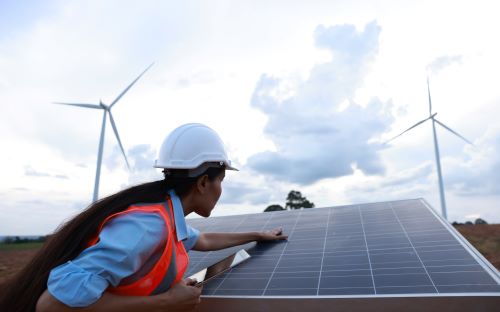India is implementing a variety of clean energy measures to hit its target of net zero greenhouse gas emissions by 2070, including plans to rapidly scale up the generation of nuclear power. However, climate experts say significant finance will be required from developed countries to phase out coal power, accelerate renewables deployment and expand the national electricity grid.
Features
India’s path to net zero: a work in progress
At the 26th Conference of the Parties (COP26) United Nations climate change summit in Glasgow in 2021, India presented its climate objectives under the ‘Panchamrit’ or ‘Five Nectar’ action plan. The plan outlined both short-term and long-term goals aimed at addressing climate change and advancing sustainability.
At the summit, Prime Minister Narendra Modi announced the country’s goals of achieving 500 gigawatts (GW) of renewable energy capacity by 2030, reducing CO2 emissions by one billion tonnes by 2030, meeting at least 50 per cent of energy requirements from non-fossil fuel sources by 2030, reducing carbon emissions by 45 per cent compared to 2005 levels by 2030, and for the entire economy to be ‘net zero’ by 2070.
Tripled levels of renewable energy capacity
The Union Government states the country is making progress towards these targets – for example, India’s total installed capacity for renewable energy surpassed the 200 GW mark by October 2024. The Central Government says India has almost tripled its renewable energy capacity since 2014, arguing the nation is therefore on track to meet its goal of 500 GW of non-fossil fuel energy capacity by 2030.
According to the Union Government’s Ministry of New and Renewable Energy (MNRE), the key sources contributing to this impressive figure include: solar power (92.12 GW), wind power (47.72 GW), large hydro projects (46.93 GW), small hydropower (5.07 GW) and bioenergy (11.32 GW).

Increase in funding
In a bid to provide further momentum to the country’s clean energy transition, the Union Budget for 2025–26 earmarked Rs 26,549.38 crore funding for the MNRE. This represents a massive 53.48 per cent increase in funding compared to the revised estimates of Rs 17,298.44 crore from the previous year. The allocation has increased by a huge 904 per cent since the financial year 2021.
Out of the total amount, the government allocated a major part – i.e. Rs 24,224.36 crore – for solar energy. This includes Rs 1,500 crore towards solar power (i.e. expansion of the national grid for solar power); Rs 2,600 crore towards Kisan Urja Suraksha Evam Utthaan Mahabhiyan (KUSUM), which subsidises farmers to install solar irrigation pumps for cultivation; and Rs 20,000 crore towards Pradhan Mantri Surya Ghar Muft Bijli Yojana, a grant scheme designed to support the installation of rooftop solar panels in around 10 million homes and in turn provide these households with up to 300 units of free electricity per month.
Green hydrogen
The 2025–26 Budget also provided an allocation of Rs 600 crore for the National Green Hydrogen Mission. This figure is a 100 per cent increase on the previous Rs 300 crore provided in the Expenditure Budget document for 2024–25. The goal is to make India a global hub for the production, use and export of green hydrogen and its derivatives.
The initial outlay for the National Green Hydrogen Mission was Rs 19,744 crore, including an outlay of Rs 17,490 crore for the SIGHT programme, Rs 1,466 crore for pilot projects, Rs 400 crore for research and development and Rs 388 crore towards other mission components.
India’s green hydrogen production capacity is projected to reach a minimum of five million metric tonnes annually, accompanied by an increase in renewable energy capacity of approximately 125 GW. By 2030, the Union Government’s targets for green hydrogen production and renewable energy are expected to attract investments of more than Rs 8 lakh crore and create more than 600,000 jobs. It is also expected that nearly 50 million metric tons of CO2 emissions will be prevented by 2030.
Nuclear energy expansion
Also, with an increasing number of countries recognising the key role of nuclear energy in achieving global net zero greenhouse gas emissions by the middle of the century (therefore keeping the UN’s goal of limiting the global temperature rise to 1.5°C within reach), India is not far behind.
The 2025–26 Budget allocated Rs 20,000 crore for the newly launched Nuclear Energy Mission, which is focused on research and development of small modular reactors (SMRs). The mission aims to develop at least five Indian-designed, operational SMRs by 2033. The Budget also included a proposal to amend the Atomic Energy Act, allowing private entities to construct small nuclear reactors, thereby facilitating the transition to greener energy sources.
In fact, India plans to reach a nuclear power generation capacity of 20 GW by 2030, with a goal of increasing this to nine per cent of the country’s overall electricity requirements by 2047.
As of 20 January 2025, India’s nuclear capacity stood at 8,180 megawatts.
Emphasising that nuclear energy is critical for achieving net zero emissions by 2070, Union Minister for Science and Technology Dr Jitendra Singh highlighted that the Union Budget outlines a significant push towards nuclear energy as part of India’s long-term energy transition strategy. The government has set a target of 100 GW nuclear power capacity by 2047, positioning nuclear energy as a major pillar in India’s future energy mix.
Crucial element of energy strategy
Dr Singh said that India’s electricity requirements are projected to rise four to five-fold by 2047. Although renewable energy sources are expanding, they alone cannot meet the base-load demand, positioning nuclear power as a crucial element of India’s energy strategy. “Achieving 100 GW of nuclear power will require a focused and determined approach, adding around 4 GW annually from now onwards,” he said, expressing optimism that this target can be achieved through effective planning and implementation.
Dr Singh added: “Opening up the nuclear sector will send a strong policy signal to industry players, boosting investor confidence and encouraging long-term investments.”
According to analysis by Reserve Bank of India (RBI) researchers, renewables and improved energy efficiency in industrial sectors have put India on track to decouple economic growth from emissions.
The researchers examined the factors contributing to the rise in carbon emissions in India from 2012 to 2022.
Over this period, energy-related CO2 emissions rose by 706 million tonnes, primarily driven by economic growth. However, gains in energy efficiency, structural transformations and reductions in the emission intensity of electricity – attributed to a greater reliance on renewable energy sources – helped slow emissions.
“India’s energy efficiency improved by 1.9 per cent annually, exceeding the global average,” said the analysis published in the recent RBI Bulletin.
Race to zero emissions
Indian public sector undertakings (PSUs) are also joining the race to zero emissions.
Indian Railways, which manages the fourth largest railway network in the world, aims to achieve net zero carbon emissions by 2030 by integrating nuclear, solar, hydropower and wind energy into its power supply. According to a report in the Economic Times, as part of these efforts, the national rail operator has initiated discussions with the Department of Atomic Energy (DAE) and the Ministry of Power (MoP) to assess the feasibility of setting up small nuclear power plants to help meet its energy needs.
If successfully adopted, the initiative will also help Indian Railways meet its goal of achieving net zero by 2030, the news report added. Under the proposed plan, the DAE and the MoP will help set up and operate the nuclear plant, including the provision of the necessary fuel, while Indian Railways will provide land for the plants.
In February 2025, while addressing the Madhya Pradesh Global Investor Summit 2025 (GIS–2025), Union Minister of Railways Ashwini Vaishnav emphasised that the railway network increasingly requires greater amounts of energy to power its operations and urged state governments to expand their renewable and nuclear energy programmes to provide the necessary clean, low-carbon power.
“I would like to request that if a nuclear power plant can be set up in Madhya Pradesh, Indian Railways would be very happy to enter into an agreement to purchase electricity from it. Wind power is also very interesting to us,” said Vaishnaw, according to ANI News.
Carbon capture and storage technologies
Meanwhile, in a separate move, last year India’s state-owned Oil and Natural Gas Corporation (ONGC) announced plans to offset nine million tonnes of carbon dioxide equivalent emissions by 2038. This ambitious plan will cost the company a staggering Rs 2 trillion.
ONGC, with its new tagline, ‘Energy: Now and Next’, is also prioritising the integration of advanced technology and the use of innovation to reach its net-zero objectives. The organisation hopes to make use of carbon capture and storage (CCS) technologies, which are currently under development, as these could potentially greatly reduce emissions from its current operations. Furthermore, ONGC is committing resources to research and development aimed at investigating the possibilities of biofuels and sophisticated battery storage systems, thereby ensuring a varied and robust strategy for sustainable energy.
Reduction in greenhouse gases
India’s 4th Biennial Update Report (BUR–4) submitted to the United Nations Framework Convention on Climate Change (UNFCCC) on 30 December 2024, highlighted a 7.93 per cent reduction in greenhouse gas emissions (GCG) in 2020 compared to 2019.
At the World Sustainable Development Summit 2025, Bhupender Yadav, Union Minister for Environment, Forest and Climate Change, said: “The Global South is driving the climate agenda, and the world now looks to India as a leader. In 2020 alone, India slashed its GHG emissions by 7.93 per cent – a testament to its commitment to climate action.”
Yadav called on developed nations to fulfil their financial and technological commitments, particularly in relation to their obligations under the Paris Agreement. He underlined the need for enhanced international co-operation in strengthening Nationally Determined Contributions (NDCs) for cutting CHGs and adapting to climate change, to ensure that all countries effectively tackle the challenges and seize the opportunities presented by climate action.
India ‘lagging behind’ on solar and wind energy capacity
However, new analysis by Climate Analytics, a global climate science and policy institute, argues that India is currently lagging far behind in adding to its solar and wind energy capacity, threatening the country’s ability to contribute to the UN’s goal of limiting global warming to under 1.5°C. At the current pace of rollout, India will fall short of the needed capacity in 2030 by 140 GW of solar and 70 GW of wind, says Climate Analytics.
The Climate Analytics report also warns that India will require large-scale investment to help phase out coal power, accelerate the deployment of renewable energy sources and drive expansion of the country’s electricity grid. International support will be key in supporting the energy transition via climate finance, says Climate Analytics.
Although many climate experts say that developed nations – historically responsible for most of the GHGs driving climate change – are both failing to curb their emissions rapidly enough and faltering on their commitments to deliver climate finance so developing countries can decarbonise and adapt to climate change, they point out that the Indian Government’s 2025 Budget fails to take a holistic approach to India’s climate agenda.
For instance, the Ministry of Environment, Forest, and Climate Change received a slight budget increase of 2.47 per cent, while funding for critical areas like industrial decarbonisation, climate adaptation and ecosystem conservation continues to fall short, warn some climate campaigners.
“With the United States under the Trump administration formally withdrawing from the Paris Agreement and terminating all financial obligations under the United Nations Framework Convention on Climate Change (UNFCCC), the world is increasingly looking to India as a global climate leader,” notes Aparna Roy, a fellow and lead for climate change and energy at the Delhi-based global climate think tank Observer Research Foundation.
“However, India’s present financial approach to climate action falls short of expectations, highlighting the critical need for policy measures that can bridge the gap between ambition and action.”
Greater ambition required
Helen Clarkson, chief executive officer of the international non-profit Climate Group, which supports businesses and governments around the world to achieve net zero, said that while India has a net-zero target (balancing emissions with removal of greenhouse gases from the atmosphere) for 2070, the country needs to show greater ambition towards reducing its carbon emissions.
Clarkson suggested that India should align with other countries in moving its net-zero goal forward.
“We would like to see more ambition from India,” she said. “It’s been very clear it has got its Nationally Determined Contributions, but it is talking about net zero by 2070. We would like to see that come forward and align with other countries.”
Meanwhile, the Economics of Energy Innovation System Transition (EEIST) project, which is funded by the UK Government and aims to support government decision-making in large developing countries on how best to decarbonise their economies, says that while the Indian Government and stakeholders like Indian businesses have made significant progress towards achieving the country’s 2070 net zero goal, “an ever greater effort” will be required to keep within the available carbon budget.
Writing for the EEIST website, Saswata Chaudhury, fellow at The Energy and Resources Institute in New Delhi, and Vidhu Kapur, a consultant at the Indian division of GIZ, Germany’s international development agency which helps countries like India to mitigate climate risks and ensure sustainable development, said:
“India is currently in the early stages of energy system transition and is presented with a variety of alternative technology choices – achieving its net zero target will require a careful balance. Informed policy-making is therefore needed to guide India along a sustainable decarbonisation pathway.”
They added: “While making decisions, policy makers should consider socio-economic impacts, and co-benefits both in the short- and long-term.
“For example, hydrogen produced using renewable energy is likely to have huge potential for transport and industry, while addressing both net zero and energy security objectives in the long-term. On the other hand, hydrogen use in these sectors is in a nascent stage and is unlikely to be widely used this decade, so focusing on promoting the use of electricity in various industrial processes and decarbonising the transport sector will be more fruitful in the short- and medium-term.
“India is the world’s second largest producer, and third largest consumer, of steel. The transport sector is India’s fastest-growing source of carbon emissions. EEIST analysis finds that innovation ‘trump cards’ like hydrogen and EVs (electric vehicles) can together rapidly transform energy use and carbon emissions in these co-dependent sectors, including in vehicle manufacture, vehicle use and surrounding infrastructure, so should be prioritised.”


FEATURES

India’s path to net zero: a work in progress
By Orchie Bandyopadhyay on 08 April 2025
India is implementing a variety of clean energy measures to hit its target of net zero greenhouse gas emissions by 2070, including plans to rapidly scale up the generation of nuclear power. However, climate experts say significant finance will be required from developed countries to phase out coal power, accelerate renewables deployment and expand the national electricity grid.

Too hot to handle: early arrival of heatwaves in India sparks calls for action to protect workers and the public
By Orchie Bandyopadhyay on 08 April 2025
Temperatures in India in February 2025 were the hottest since records began over a century ago, prompting warnings the country needs to urgently step up efforts to protect both workers and the general population from the health risks posed by extreme heat and humidity.

